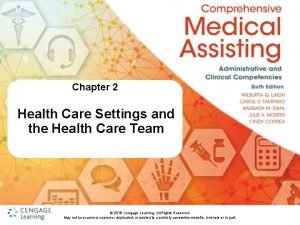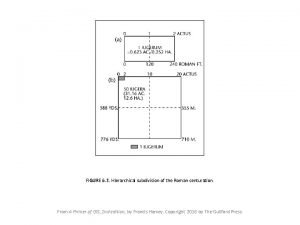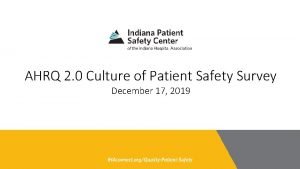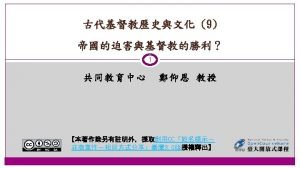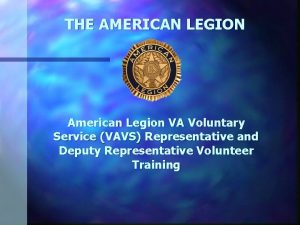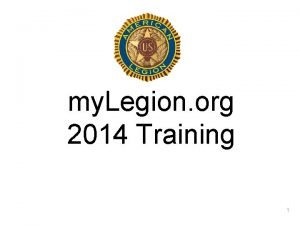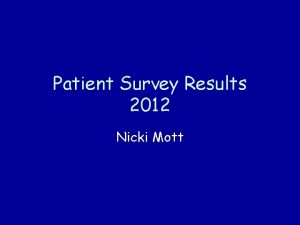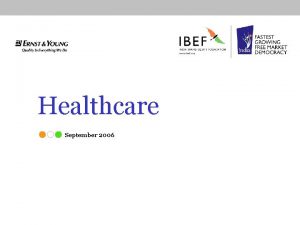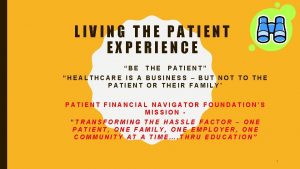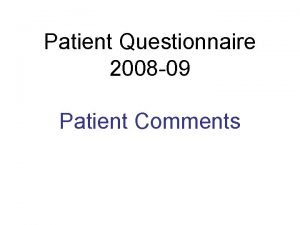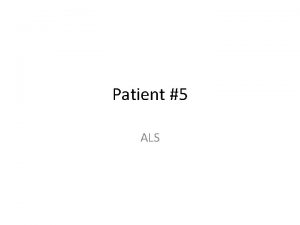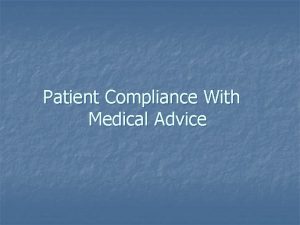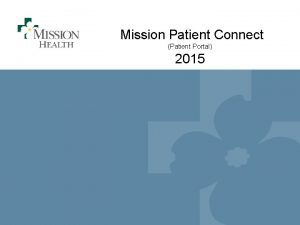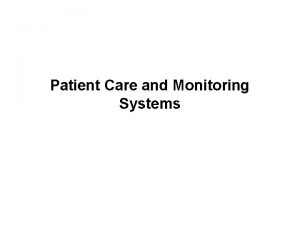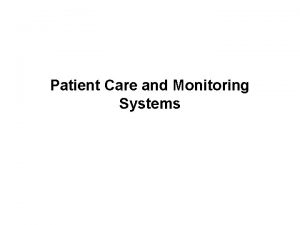The American Legion Survey of Patient Healthcare Experiences





















































- Slides: 53

The American Legion Survey of Patient Healthcare Experiences Jeff Greenberg, Ph. D. Data Recognition Corporation (DRC) Institute for the Advancement of Military and Veteran Healthcare

Introduction Data Recognition Corporation (DRC) is a large, woman-owned business which focuses on survey and healthcare research, educational testing, and document production. Jeff Greenberg, Ph. D. , Senior Director of Research and Director of the DRC Institute for the Advancement of Military and Veteran Healthcare, is a clinical psychologist who completed his training in the Boston VA system, the National Center for PTSD, Harvard University Medical School, and Boston University Medical School. 2

Introduction Dr. Greenberg is a researcher whose focus has been on Military and Veteran mental healthcare, posttraumatic stress disorder (PTSD), Traumatic Brain Injury (TBI), complex co-occurring disorders, depression, anxiety, substance abuse, suicide, and healthcare quality and fidelity. Dr. Greenberg has published on PTSD and TBI and depression amongst Military and Veteran populations. He has served as a subject matter expert for Navy Medicine and Do. D Medicine, where he has focused and advised senior leaders on mental health, clinical care, training, and policy. 3

Overview of the Survey Collaboration between the American Legion and Data Recognition Corporation (DRC) Exploratory research regarding • Type of care patients report receiving for PTSD and TBI • Patients’ perceptions of effectiveness of treatment • Patients’ reports of access to a range of treatment options, including Complementary and Alternative Medicine (CAM) Quick turnaround study 4 First step in long-range program to encourage treatment options and fidelity to treatment

Need for the Research Limited information on types of treatment Veterans receive Limited research documenting fidelity to treatment models Limited knowledge about use of CAM Limited evidence of effectiveness of CAM 5

Purpose of the Survey To obtain a snapshot of what treatments Veterans are receiving and how they perceive them; and To obtain information to help guide more rigorous, in-depth research to support the establishment of treatment models and an eventual system of fidelity modeling. 6

Methodology Web survey (opt-in) Content: demographics, treatment received, access to CAM, perceived change in symptoms and reasons for treatment termination Press releases and social marketing to recruit respondents 30 -day field period Analysis: frequencies and other descriptive statistics 7

Key Findings Respondents reported common symptoms: Elevated Anger, Pain, Sleep Problems, Anxiety, Depression and Irritability. For PTSD, individuals are receiving multiple therapy types with fewer than a quarter of respondents receiving treatment in conformity to Do. D/VA evidence-based practice models of care.

Key Findings (continued) For TBI, individuals are receiving a wide array of treatment types. Medication appears to be the front line treatment reported by respondents. A sizable proportion of respondents reported prescriptions of up to 10 medications for PTSD/TBI across their treatment experience.

Key Findings (continued) Broadly, respondents reported limited change following treatment for PTSD and TBI: • Following therapy, the majority of respondents reported no change or worsening of symptoms; • Following medication, a slight majority reported no change or worsening of symptoms; and • In general, approximately half of all respondents reported no change or minimal improvement in symptoms.

Key Findings (continued) Nearly half of all respondents had discussed some type of CAM-based treatment with their providers. Respondents reported numerous types of CAM treatments, especially Meditation, Relaxation, and Stress Reduction.

Key Findings (continued) 30 percent of respondents indicated they had terminated treatment prior to completion. An array of rationales for treatment termination were reported. In declining order, the rationales cited were: Lack of Improvement, Side Effects, Dissatisfied with Provider, Solve Problems on My Own, Time Burden or Distance to Treatment, and Stigma

Survey Response 14, 734 views overall, with nearly 480 per day 3, 209 starts 3, 116 completions (nearly 22 percent of viewers became completers) 17 -minute average completion time 98 percent of completers in the United States 74 percent used laptop, 16 used percent smart phone, 10 percent used tablet 97 percent Veteran, 3 percent spouse or other

Respondent Characteristics

Respondent Characteristics

Service-Connected Disability

Service-Connected Disability

Community

Location of Care Received

Care Received at a Private Facility

Frequency of Care for PTSD and/or TBI

Provider Type

Symptom Architecture and Severity

Symptom Architecture and Severity

Symptom Ratings

Level of Perceived Improvement 10 point Likert scale: 1= I got worse, 5 = No change, and 10 = I got better

Symptom Change Following Therapies N = 2, 309 (41% report improvement and 59% report no change or worsened)

Symptom Change Following Medication N = 2, 212 (48% report improvement and 52% report no change or worsened)

PTSD Treatment Type

TBI Treatment Type

Prescriptions for PTSD and TBI

Discussed CAM Treatments with Provider

CAM Treatment Type for PTSD

CAM Treatment Type for TBI

Terminated Treatment Prior to Completion

Reason Given for Terminating Treatment

Recommendations To establish a knowledge base on the care of Veterans with PTSD and TBI, a multi-step program of research is needed over a period of years: • Establishment of baseline date, building on information gathered here, but probing more deeply and capturing data suitable for correlations and statistical modeling; • Surveys to track progress over time; • Funding of demonstration programs to test effectiveness of alternative treatments and to generate best practices and models of care as well as update practice guidelines with new findings; and • Establishment of system for monitoring and evaluating fidelity of care.

Recommendations (continued) Simultaneously, a second track of research and development is needed to ensure the availability of a trained work force prepared to treat PTSD and TBI. That will entail steps parallel to the development of models of care: • Ancillary research on professional development related to treatment of PTSD and TBI; • Development of professional standards and collaboration with schools to build curricula that support standards of care; • Establishment of a National Advisory Group to plan the multi-step research program; and • Regular tracking surveys. 38

Next Steps Establish a National Advisory Group to plan the multistep research program. Refine survey design in preparation for collection of baseline data and tracking surveys. 39

Timeline FY 2015: Establish National Advisory Group. FY 2016: Begin Research: • Conduct Research to Establish Baseline on Treatment of PTSD and TBI; and • Conduct Research on Professional Development. FY 2017: • Announce 3 -Year Demonstration Program; and • Establish Work Group to Collaborate with Professional Schools. FY 2018: First Tracking Survey. 40

Timeline (continued) FY 2020: Second Tracking Survey. FY 2021: Establish Practice Guidelines/Models of Care. FY 2022: Establish Monitoring and Evaluation System to Measure Fidelity to Models of Care, Examining both Treatment Provided and Professional Development of Health Care Providers. FY 2022 and Beyond: • Continue Bi-annual Tracking Surveys/Integrate with Monitoring. • Process for Ongoing Integration of Tested Innovations. 41

Thank You 42

Backup Slides

Anger

Pain

Sleep Problems

Anxiety

Depression

Irritability

Tour of Duty

Telehealth

Travel Time

Treatment Mode
 American legion youth camp cheltenham md
American legion youth camp cheltenham md Sam johnson park redmond oregon
Sam johnson park redmond oregon American legion riders patch rules
American legion riders patch rules American legion converse
American legion converse American legion meeting protocol
American legion meeting protocol American legion post 101
American legion post 101 The american legion temporary financial assistance
The american legion temporary financial assistance Healthcare and the healthcare team chapter 2
Healthcare and the healthcare team chapter 2 Healthcare and the healthcare team chapter 2
Healthcare and the healthcare team chapter 2 Skill survey healthcare hiring
Skill survey healthcare hiring What are the experiences of latin american countries
What are the experiences of latin american countries Roman legion subdivision
Roman legion subdivision Legion google drive
Legion google drive Legion of mary usa
Legion of mary usa Salararius
Salararius Patient 2 patient
Patient 2 patient Imt group 2 specialties
Imt group 2 specialties Ahrq patient safety survey
Ahrq patient safety survey Abcd in acls
Abcd in acls American statistical association salary survey
American statistical association salary survey Thể thơ truyền thống
Thể thơ truyền thống Chúa sống lại
Chúa sống lại Sự nuôi và dạy con của hươu
Sự nuôi và dạy con của hươu Từ ngữ thể hiện lòng nhân hậu
Từ ngữ thể hiện lòng nhân hậu Diễn thế sinh thái là
Diễn thế sinh thái là Vẽ hình chiếu vuông góc của vật thể sau
Vẽ hình chiếu vuông góc của vật thể sau Làm thế nào để 102-1=99
Làm thế nào để 102-1=99 Tỉ lệ cơ thể trẻ em
Tỉ lệ cơ thể trẻ em Lời thề hippocrates
Lời thề hippocrates Vẽ hình chiếu đứng bằng cạnh của vật thể
Vẽ hình chiếu đứng bằng cạnh của vật thể đại từ thay thế
đại từ thay thế Quá trình desamine hóa có thể tạo ra
Quá trình desamine hóa có thể tạo ra Các môn thể thao bắt đầu bằng tiếng đua
Các môn thể thao bắt đầu bằng tiếng đua Cong thức tính động năng
Cong thức tính động năng Hát kết hợp bộ gõ cơ thể
Hát kết hợp bộ gõ cơ thể Sự nuôi và dạy con của hổ
Sự nuôi và dạy con của hổ Thế nào là mạng điện lắp đặt kiểu nổi
Thế nào là mạng điện lắp đặt kiểu nổi Dot
Dot Nguyên nhân của sự mỏi cơ sinh 8
Nguyên nhân của sự mỏi cơ sinh 8 Phản ứng thế ankan
Phản ứng thế ankan Chó sói
Chó sói Thiếu nhi thế giới liên hoan
Thiếu nhi thế giới liên hoan điện thế nghỉ
điện thế nghỉ Một số thể thơ truyền thống
Một số thể thơ truyền thống Thế nào là hệ số cao nhất
Thế nào là hệ số cao nhất Trời xanh đây là của chúng ta thể thơ
Trời xanh đây là của chúng ta thể thơ Ng-html
Ng-html Sơ đồ cơ thể người
Sơ đồ cơ thể người Bảng số nguyên tố
Bảng số nguyên tố đặc điểm cơ thể của người tối cổ
đặc điểm cơ thể của người tối cổ Vẽ hình chiếu vuông góc của vật thể sau
Vẽ hình chiếu vuông góc của vật thể sau Các châu lục và đại dương trên thế giới
Các châu lục và đại dương trên thế giới Glasgow thang điểm
Glasgow thang điểm ưu thế lai là gì
ưu thế lai là gì







